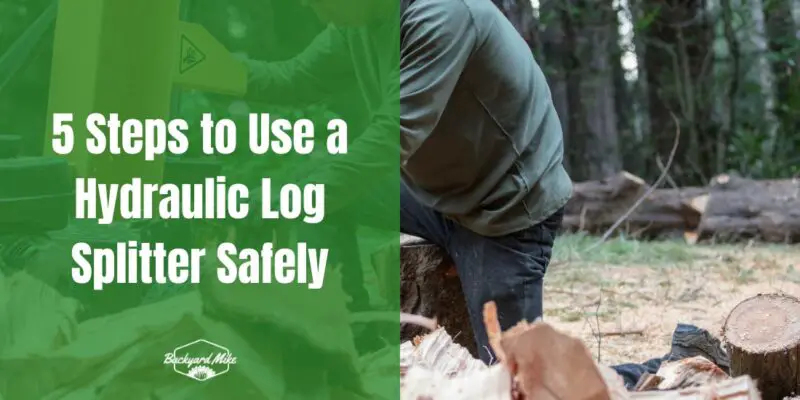To use a hydraulic log splitter safely, inspect it thoroughly for damage and verify fluid levels are correct. Set it on a flat surface, clear any obstacles, and don't work in poor weather. Select logs within the splitter's capacity; squarely cut ends prevent slippage. Wear protective gear like goggles, steel-toe boots, and gloves. Maintain your equipment by checking hoses and blades. Follow these steps to gain further insights into operating your log splitter effectively and safely.
Key Takeaways
- Conduct a thorough pre-use inspection, checking fluid levels and looking for visible damage or leaks.
- Ensure the work area is clear, level, and well-lit, keeping unauthorized individuals away.
- Choose logs within the splitter's capacity and center them on the beam for even pressure.
- Wear protective gear, including goggles, steel-toe boots, gloves, long sleeves, and hearing protection.
- Regularly inspect and maintain equipment, ensuring fluid levels are adequate and moving parts are lubricated.
Preparing for Safe Operation
Before you operate a hydraulic log splitter, it's essential to prepare properly to guarantee a safe experience. Start with a thorough pre-use inspection. Check the hydraulic fluid levels and look for any leaks that might compromise safety. Inspect the machine for visible damage or signs of wear, ensuring all safety devices are intact and operational. Verify that the beam is securely locked for operation, and examine hydraulic pipes for wear or damage. Understanding equipment mechanics is important. Familiarize yourself with the control handle's settings—forward, neutral, reverse—and know how to stop the splitter quickly. Grasp the hydraulic system's working mechanism and safety features, such as function interrupt valves, as they play a key role in safe operation. It is crucial to read and understand the specific manual for the log splitter being used to ensure proper operation and safety.
Ensuring Work Area Safety
When setting up your work area for operating a hydraulic log splitter, prioritize stability and safety.
Position the splitter on a flat, level surface to prevent accidents. Block the wheels to guarantee it stays put during operation. Keep your work area clear of clutter to reduce tripping hazards, and remove any obstacles that might interfere with movement. Avoid working in muddy, wet, or icy conditions to prevent slips and falls. Ensure the workspace is well-lit, stopping work if light is insufficient to maintain a safe environment. Make sure pathways are clear and accessible, marking boundaries to keep unauthorized individuals away. Keep pets and bystanders at a safe distance to avoid potential hazards. Verify the area is well-lit for visibility, and check for electrical safety, avoiding exposed wires or standing water.
Selecting and Preparing Logs
After securing your work area, it's time to focus on selecting and preparing the logs for splitting.
Choose logs that fit your splitter's capacity—typically no longer than 24 inches and up to 12 inches in diameter for smaller machines. Consider the log types, as hardwoods demand higher tonnage than softwoods. Assess moisture levels; dryer logs are easier to split, though more powerful machines can handle wetter logs. Gas-powered splitters, which are more powerful than electric models, are ideal for heavy-duty tasks and can handle larger and tougher logs with ease. Confirm both ends of each log are cut square to prevent slippage. Properly position logs on the splitting beam, centering them for even pressure distribution. For larger logs, slice cuts might be more effective than center cuts, reducing the risk of jamming.
Carefully adjust logs by hand before splitting.
Wearing Protective Safety Gear
Ensuring you wear the right protective safety gear is essential when operating a hydraulic log splitter, as it greatly reduces the risk of injury. Start with protective goggles maintenance; they shield your eyes from flying wood chips, so clean them regularly for clear vision. Choose safety goggles over regular glasses for impact protection. For your feet, boot selection is vital. Opt for steel-toe or work boots with a good grip to prevent slipping and protect against falling logs. Make sure they're in good condition and cover your ankles. For hand safety, snug-fitting, heat-resistant gloves prevent cuts. Wear long sleeves and pants to guard against splinters. Appropriate safety gear is crucial to work confidently and comfortably with your equipment. Finally, use earmuffs or earplugs to protect your hearing from loud machinery noises.
Operating and Maintaining Equipment
With your protective gear in place, it's time to focus on the operation and maintenance of your hydraulic log splitter.
Start with thorough equipment checks, inspecting hoses, blades, and components for wear. Ascertain the log splitter is on a flat, level surface, and the wheels are chocked. Check hydraulic fluid levels, keeping the reservoir about three-quarters full. It's essential to bleed air from the hydraulic cylinder after adding fluid to ensure smooth operation.
For operation, position logs securely, aligning them with the wedge. Set the throttle to maximum for peak power. If logs don't split, retract the cylinder; never force stuck logs.
After use, clean the splitter, check for hydraulic fluid leaks, and lubricate moving parts. Store it in a dry place, documenting maintenance and repairs to keep your log splitter in top condition.
Frequently Asked Questions
How Often Should I Check the Machine for Maintenance Needs?
You'll want to check your machine regularly. Create a maintenance schedule and an inspection checklist. Doing this builds a sense of community among users, ensuring everyone's equipment runs smoothly and safely. You'll feel more connected and confident.
What Should I Do if the Log Splitter Gets Jammed?
If your log splitter gets jammed, shut it off immediately. Prioritize safety measures and inspect for jammed logs. Check the hydraulic system, adjust pressure settings, and manually retract if needed. Join the community in safe, effective splitting!
How Can I Safely Store the Log Splitter When Not in Use?
Storing your log splitter safely is like crafting a masterpiece—attention to detail is key. Embrace proper storage techniques and safety precautions, ensuring it remains away from ignition sources, well-ventilated, dry, and out of children's reach.
Is There a Proper Way to Dispose of Old Hydraulic Fluid?
You've got to follow environmental regulations for hydraulic fluid disposal. Recycle through compliant services or use third-party waste management. This guarantees you're protecting the environment and staying within the community's standards for safety and responsibility.
What Should I Do if the Machine Starts Making Unusual Noises?
When unusual sounds echo like a haunted house, don't panic. Check hydraulic pipes, seals, and fluid levels. Follow troubleshooting tips to identify the culprit. Address issues swiftly to keep your machine running smoothly and guarantee you belong in the DIY community.
Conclusion
By following these steps, you'll guarantee safety when using a hydraulic log splitter. First, prepare for safe operation by checking the equipment. Next, verify your work area is clear and organized. Then, select and prepare logs carefully, confirming they're suitable for splitting. Wear protective safety gear to guard against injury. Finally, operate and maintain the equipment properly, checking for any issues. By taking these precautions, you'll split logs efficiently and safely, minimizing risks and maximizing productivity.


